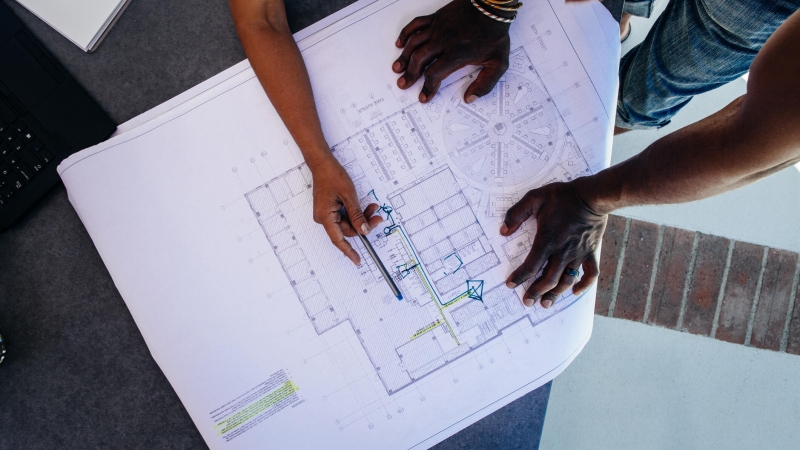Designing a building or business requires experience in architectural design and a background in structural engineering. In the past, creating a hotel floor plan would require a team of experts and a significant budget to pay for their services. With the help of modern technology and powerful software, however, anyone can design functional, efficient, and attractive hotel floor plans—including you!
This guide explains everything you need to know about hotel floor plans and their impact on guests’ perceptions. We explore how to create, redesign, and refresh hotel floor plans and different options for varying property types. We examine event layout management and review interactive tools hotels can use to manage meeting spaces, public spaces, guestrooms, and more. If you’re looking for tips, tricks, or tools you can use to refresh your hotel’s floor plan, this is the guide for you.
Build hotel floor plans that benefit your property
What is a hotel floor plan?
Floor plans show every element that makes up the structure of a building, including walls, windows, doors, stairs, and mechanical systems like electricity and plumbing. They outline the size and measurements of specific spaces, such as individual rooms, hallways, elevator shafts, or meeting rooms. Similar to a road or topography map, hotel floor plans typically use symbols to represent specific elements on the diagram and include a key that denotes the meaning of each.
Hotel floor plans are comprehensive and detailed. They outline every planned hotel feature, room, area, and intended purpose. Your hotel floor plan should include the following:
• Interior and exterior walls
• Hotel communal areas (e.g., lobby, reception station, dining room, fitness centre)
• Meeting and event rooms
• Guestroom layouts (i.e., living, working, and bathing spaces within)
• Walking corridors, hallways, etc.
• Doors, windows, lifts, and staircases
• Room, wall, and spatial dimensions
Different types of hotels will require varying floor plan styles. Multi-level properties would have individual floor plans for each level, outlining the specific layout of each floor. A motel, for example, may only have a single floor plan, whereas a large, branded hotel or resort may require multiple floor plans for levels with differing layouts. In a multi-level hotel, the lobby, dining area, fitness centre, and meeting rooms typically reside on the first floor. A few guestrooms may also lie on the first floor, but the ground level is often reserved for specific, shared hotel spaces.
Why are hotel floor plans necessary?
Having well-designed floor plans in place will allow for the proper time, budget, and resource allocation required to make your dreams a reality. They help hoteliers better estimate the materials, workforce, and funds necessary to build a property. Furthermore, thoughtful preparation will help the hotel get up and running faster, speeding up the required mortgaging, leasing, and legal processes.
In addition to appropriate resource allocation, hotel floor plans play an essential role in the guest-hotel relationship, impacting the customer experience at your property. The layout of your property can affect guest comfort, satisfaction, safety, security, and the hotel’s potential to better meet those needs in the future.
• Guest comfort and satisfaction
A hotel’s layout can significantly impact how guests feel while viewing your property online or moving through the space in real life. Hotel floor plans should create a smooth, seamless path throughout the hotel, making it easy for guests to move from one area to another while preventing overcrowding. Displaying the floor plan online and in marketing materials can also help guests get a sense of what visiting your hotel would feel like.
• Guest perception
The interior and exterior of a hotel have been shown to significantly impact guests’ perception, customer loyalty, and satisfaction. In addition to reviewing the general hotel layout, potential hotel guests may also review guestroom floor plans to check the design of individual rooms at your hotel. They may scan floor plans to assess whether they will feel safe and comfortable while staying at your property.
When booking online, a potential guest may review floor plans for various hotel room types to determine which option best suits their needs. A guest may ask a variety of questions while examining room layouts, such as:
• Do rooms look spacious, or do they appear cramped?
• Will I get a good night’s sleep in this room?
• Is there space to work? Is there a designated workstation?
• Could a digital nomad transition between work and play comfortably?
• Is a kitchen or kitchenette present?
• If multiple guests stay in the same room, will they have any privacy?
• Does the room have a bathtub or only a shower?
• Could a family comfortably stay in a suite for weeks while on holidays?
• Is the layout of guestrooms designed to accommodate extended stays?
• Guest safety and emergency preparedness
Guest safety and security should be at the forefront of all hotel planning, especially when confirming hotel floor plans. Capacity restrictions, emergency exit paths, fire routes, and proximity to dangerous mechanisms, like electrical or maintenance equipment, should be demonstrated within floor plans.
Another role of hotel floor plans is to provide an emergency evacuation route for each floor, ensuring that guests and hotel staff can exit the property safely in an emergency. A required safety regulation, every hotel must display the floor plan that outlines the evacuation route for guests. A unique evacuation map must be present in each guestroom, as the path to safety would differ for each traveller based on their location inside the hotel. Ensuring every hotel visitor has access to emergency materials can help guests feel safer at your property.
• Prepare for future progressions
A well-thought-out floor plan enables a hotel to make adjustments throughout the planning process. They can alter the original blueprint if a particular design or element doesn’t work as expected. In addition, the ability to refer back to original floor plans will make future hotel renovations much easier to organise and execute.
How to build hotel floor plans
Drop your rulers, erasers, and drafting tools, and design a hotel floor plan the straightforward way: with intuitive software. There are numerous platforms and tools hotels can use to build a floor plan, including:
• SmartDraw: Build professionally designed hotel floor plans in a snap using pre-made templates. Merely add windows, doors, hallways, and other elements to make the built-in designs your own.
• Visrez: Providing designers with an immersive view of their future hotel, Visrez is a 3D visualisation platform that creates three-dimensional renderings of hotel floor plans.
• Planning Pod: Create hotel and event floor plans easily using Planning Pod’s reusable event templates, snap-to guides, and drag-and-drop floor plan builder.
• Event Diagramming: Hoteliers trust Cvent for collaborative event planning software that saves time, drives revenue, and boosts customer loyalty. Demonstrate how your property can uniquely accommodate planners’ needs by quickly changing hotel floor plans into even layouts that are precise to scale.
While the individual tools, services, and built-in templates will vary depending on which floor plan software you choose, the basic steps for designing hotel floor plans remain the same. To develop a hotel floor plan with software, follow these steps:
1. To create a hotel floor plan, first place the walls. Use software to drag and drop the walls of the room or floor you are designing, from the exterior walls to interior spaces and partitions.
2. When placing the walls, work to scale to ensure that your spacing and layout are accurate. Determine the dimensions of each room, and use a spacing tool to guarantee that your design fits inside the allotted amount of space allocated to the hotel.
3. Add windows, elevator shafts, stairs, housekeeping service stations, storage, and other functional hotel areas.
4. As you create individual rooms and spaces, add text or symbols to detail the room’s purpose (e.g., lobby, dining area, bathroom, business centre). This enables anyone viewing the floor plan to quickly identify what each space represents and what each room will be.
5. As the layout grows, focus on precision and making the floor plan easier to read. For example, make the exterior walls thicker than the interior ones for fast identification.
6. After completing the hotel’s general floor plan, you can begin creating individual floor plans for each space, detailing the layout of the kitchen, spa, sundry shop, front desk reception area, and so on.
Review drafted floor plans with the hotel owner, operator, contractor, and building crew. Confirm that you have the space, materials, financing, and time required to bring your plans to life.
Tips for creating hotel floor plans
When creating the floor plan for your hotel, follow these tips to design a better space for guests and employees alike:
• Leave ample room for foot traffic. Consider which areas will have the highest traffic, as they will likely be hotel matting zones. Allow enough spacing for guests and staff to move comfortably throughout those areas.
• Include adequate lobby space. Every busy guest area should have lobby space or seating to accommodate guest and visitor rushes. Provide places for guests to sit and rest or to move around in crowded spaces. Consider providing convenient restroom access near busy areas, such as meeting rooms, dining areas, or the hotel fitness centre.
• Embrace flexibility. Guest and traveller needs are constantly changing, evolving from one year to the next. To better accommodate changing guest requirements, preferences, and requests, to give guests what they want from a hotel, create an amendable layout that can be adjusted to fit changing guest expectations. Design versatile spaces that accommodate various functions, activities, and guest needs.
• Focus on functionality. Even in massive, open hotel spaces, each inch should be used efficiently. Every wall, corner, and hallway should be functional and utilised in the most effective way possible. From flexible furniture that serves multiple purposes, such as guest storage that doubles as a work desk, to communal guest spaces, like meeting and event rooms, multi-functional designing helps hoteliers make the most of their space.
• Match the interior floor plan to the building’s exterior. Floor plans tell the story of your hotel. A storyline formation, or hospitality concept design, uses a hotel’s floor plan to tell the property’s story through architecture and layout. For example, if your hotel has a modern design, the floor plan should demonstrate inspiration from modern architectural design. On the other hand, a classically designed property would reflect a cohesive classical floor plan. When the floor plan matches the hotel’s design formation, it can function as a unique selling point (USP) for the property.
• Factor lighting into your design. Keep the sun’s orientation in mind, where it rises and sets. When/where will sunlight flow into the property? Based on your orientation, will the morning sun blind guests in the dining room as they enjoy breakfast, or will the setting sun help save on energy costs by illuminating communal spaces in the afternoon?
• Design the layout of guestrooms thoughtfully. Keep guest comfort and satisfaction at the forefront of your mind when designing private spaces. Put yourself in the guest’s shoes, and imagine how a stay would feel based on your current floor plan. Does the layout make sense? For example, placing a bathroom beside a kitchenette could lead to uncomfortable in-room situations. Spacing them farther apart would help correct that problem.
• Make the health and safety of guests and employees a top priority. Consider your customer demographics and what would make them feel safest. For example, corporate guests may travel with expensive equipment, like computers, laptops, or tablets. An interior guestroom entrance, protected by a digital keypad, could make travellers feel more secure than exterior entry accessible to guest parking areas.
Use hotel floor plans to attract more business
Display your hotel’s floor plan in print, online, and digital marketing materials. Include printed versions of suite and room layouts in marketing materials, highlighting each room type's unique features, amenities, and floor plan. Expand the reach of marketing materials by sharing hotel floor plans on social media, the hotel website, and your Cvent Supplier Network venue listing.
To attract more online attention, allow guests and travel planners to visualise what a stay at your property would be like by promoting an immersive virtual hotel tour. Create and schedule automated emails inviting prominent past guests, MICE contacts, and travel planners to experience your hotel in an exciting new way through a dynamic, photorealistic 3D rendering. Share the intricate details of your space with potential customers, and gain an edge over the competition by proving that your space can accommodate a guest or planner’s exact needs.
Frequently asked questions about hotel floor plans
1. What infrastructure details should you include in a hotel floor plan?
In addition to physical spaces, like breakrooms, guestrooms, or the hotel spa, hotel floor plans should also feature infrastructure systems. For operations to take place uninterrupted and out of the sight of guests, hotels must account for the space needed for mechanical systems, like heating and air systems, and transportation areas, such as stairs and elevators, plumbing, and back-of-the-house service areas.
2. Are there free tools for creating a hotel floor plan?
There are multiple free software options for floor planners designing on a budget. RoomSketcher, EdrawMax, and SocialTables have free, easy-to-use hotel floor plan building software.
3. Can you refresh or update hotel floor plans?
Yes! Major hotel renovations often include significant changes to hotel floor plans. Whether redesigning guest rooms, the lobby, or the entire property, the general layout could change due to renovations, projects, or repairs. When refreshing or updating hotel floor plans, work from the original blueprint to avoid significantly damaging the structure or integrity of the building.
Put this guide to good use, and revitalise your hotel floor plans!
Now that you know the ins and outs of hotel floor plans, you have the tools and resources required to build your own! Review various software options to determine the best solutions for your property. Even if you’re not building a new hotel anytime soon, spend some time exploring planning software and interactive layouts. Working with floor plan tools could help you identify potential areas of improvement or a more efficient hotel floor plan to adopt in future renovations.
After planning the physical layout of a hotel, designing the interior comes next. Whether you’re decorating a brand-new property or looking for ways to reinvigorate your current look, we can help.





